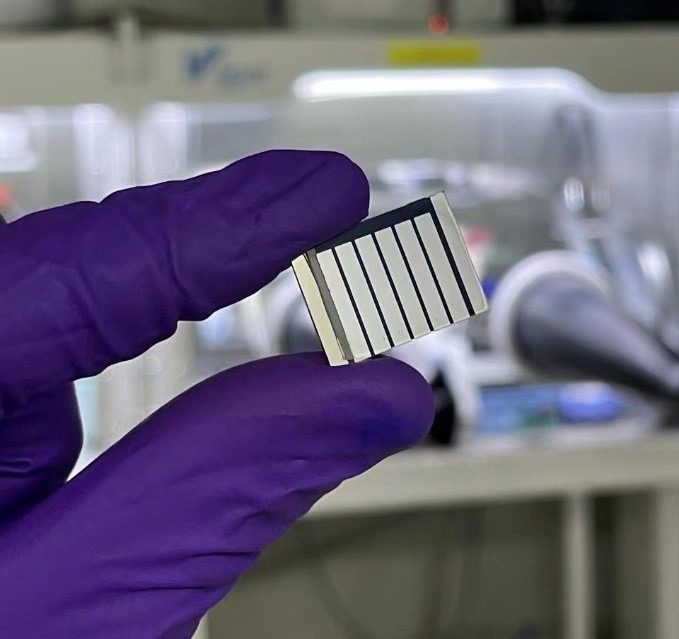Scientists from the Hefei Institutes of Physical Science (HFIPS) at the Chinese Academy of Sciences have introduced a novel and highly promising approach for manufacturing uniform perovskite films for solar cells.

Perovskite solar cell. Image Credit: Pan's team
The study was featured in the prestigious journal Nature.
This method focuses on preventing phase segregation resulting from internal variations in cations, which has led to a remarkable increase in conversion efficiency, achieving an impressive 26.1%. This achievement matches the current record in the field.
Their research was slated for publication as part of the Accelerated Article Preview and was also recognized as a Nature Editor's Pick, underscoring its significance and impact on the scientific community.
In solar cells, a crucial focus for scientists and engineers worldwide is the quest for enhanced conversion efficiency while simultaneously ensuring the long-term stability of these cells. This pursuit underscores the core challenges in the field.
Lead-halide perovskite solar cells (PSCs) have garnered extensive attention owing to their remarkable efficiency. However, there has been a notable deceleration in the rate of growth of their conversion efficiency. It is worth noting that the majority of previous research on these cells has primarily concentrated on surface characteristics, dopant effects, and individual component analysis.
However, Xu Pan, a solar cell scientist at HFIPS, and his research team chose a different approach.
They delved deeper into the perovskite films, investigating at the phase level. Drawing from their extensive experience in the field, these scientists recognized that phase segregation occurs within perovskite films, which has a detrimental impact on both the conversion efficiency and long-term stability of the solar cells.
We all know from previous work that cations in different groups are distributed inhomogeneously, but how exactly these cations are distributed and the reasons behind it and how it affects efficiency remain unclear.
Xu Pan, Solar Cell Scientist, Hefei Institutes of Physical Science, Chinese Academy of Sciences
In their quest to comprehend the behavior of cations within perovskite films, the researchers employed experimental methods to quantify the vertical distribution of cations, namely FA+ and Cs+.
Cs+ likes to aggregate at the bottom of the film, while a large amount of FA+ gathered at the upper interface of the film.
Xu Pan, Solar Cell Scientist, Hefei Institutes of Physical Science, Chinese Academy of Sciences
To substantiate their findings, they extended their investigation to the distribution within the crystalline phase. These various experiments produced consistent results, marking the team as the pioneers in observing out-of-plane inhomogeneous cation distribution in a laboratory setting.
However, the researchers were not content with merely identifying this distribution pattern. They sought to delve deeper and understand the underlying reasons and potential solutions. To achieve this, they carried out an in-situ test aimed at uncovering the precise mechanisms driving this inhomogeneity.
Then we found that cations in different groups crystallize and transform at very different rates.
Xu Pan, Solar Cell Scientist, Hefei Institutes of Physical Science, Chinese Academy of Sciences
Pan and his team determined that this inhomogeneity was the root cause of the issue. Having pinpointed the core problem, they devised a solution involving the use of 1-(Phenylsulfonyl)pyrrole (PSP) as an additive. This strategy was designed to address disparities in crystallization and phase transition rates, ultimately leading to the production of uniform perovskite films.
Their efforts yielded impressive results, as the conversion efficiency significantly increased to 25.8% under third-party certification. Even more noteworthy, the cells exhibited long-term stability, maintaining a conversion efficiency as high as 92% of the original value even after undergoing 2,500 hours of maximum power point tracking.
Based on public reports, this achievement equals the existing record for conversion efficiency. In sum, Pan and his team's work in optimizing the phase of solar cells presents a promising technological pathway for enhancing both the efficiency and stability of solar cell conversions.
Journal Reference
Liang, Z., et al. (2023). Out-of-plane cations homogenise perovskite composition for solar cells. Nature. doi.org/10.1038/s41586-023-06784-0.